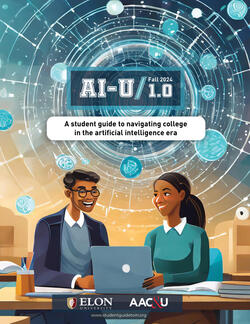Resources on Generative AI in the Classroom
Syllabus & Assignment Statements on Generative AI
The availability of generative AI tools is now so ubiquitous that we all--students, faculty, and staff--can hardly avoid it. The TLC supports faculty in providing clear and frequently-referred-to guidance to students in your classes regarding if, how, and when generative AI is appropriate to use.
A syllabus statement regarding generative AI is a necessary place to start. We also recommend providing specific guidance on each major assignment in your course.
Consider using a tool like the AI Policy Generator to help create these syllabus and assignment statements quickly and easily.
How Generative AI is Impacting Geneseo
The Geneseo Center for Digital Learning is curating a collection of lessons, articles, and blog posts showing the ever-expanding way that Geneseo is responding to artificial intelligence. See what some of your colleagues are doing in their classroom practices here, and consider sharing your own work as part of the collection.
Optimizing AI in Higher Education
For Educators
This guide, released in its 2nd edition by the SUNY FACT2 Council in May, 2024, is an extremely valuable resource to consider the alignment of emerging technology in your own teaching practice.
- an updated edition is expected to release late in 2025
"In this Optimizing AI in Higher Education: SUNY FACT2 Guide, Second Edition, you will find updated information to reflect the changing landscape of generative AI technology. We offer practical suggestions for how to help educators and students achieve AI literacy and find the right methods of using or eschewing generative AI in their pedagogy."
Access Optimizing AI in Higher Education. (The second download link on the page will take you to the full document; the first download link is only the cover art image.)
Student Guide to Artificial Intelligence
For Learners

Elon University and AAC&U published this comprehensive guide for students in the new landscape of AI in the fall of 2024. This is a very reader-friendly review of the different terminology, use possibilities, and strategies for effective use of this new technology. While overall it is a use guide for AI, it also contains a healthy perspective on the importance of fact-checking, ethical use, and building skills through traditional writing and revising strategies.
Shared with a Creative Commons license, this guide is recommended for all higher education students and can be shared broadly with your classes.